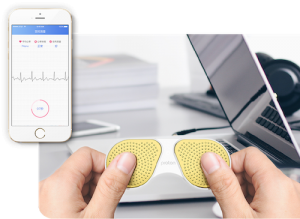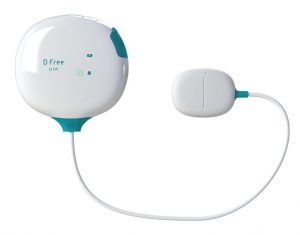While we like to think of emerging technology as being for the new generation – those early adopters who are quick to jump on the latest and great innovations – the truth is that we live in a rapidly aging population. And while lots of new technology appeals to the desires and needs of Millennials and younger, there is plenty that is geared toward the older, aging person.
Some have referred to the current state of affairs as the “silver tsunami,” describing the fact that more people than ever are approaching retirement age. Interestingly, while many older people frown upon technological development, health care is one area where technology can really make a difference.
Beyond the ability for doctors to monitor patients remotely through smart devices, electronic health records (EHRs), and other similar solutions, there are lots of start-up companies launching health tech devices for the aging population.
Proton CarePatch ECG Card
 This Chinese company developed this device, which allows you to capture heart-related data within half a minute. Place your thumbs atop small electrodes and the data is sent to the CarePatch Cloud Platform. You can then see your personal health record and share it with a doctor. The device tracks things like atrial fibrillation, arrhythmia, premature beats, bradycardia, and tachycardia.
This Chinese company developed this device, which allows you to capture heart-related data within half a minute. Place your thumbs atop small electrodes and the data is sent to the CarePatch Cloud Platform. You can then see your personal health record and share it with a doctor. The device tracks things like atrial fibrillation, arrhythmia, premature beats, bradycardia, and tachycardia.
Domalys Aladin Lamp
These smart lamps can be installed in different rooms of an elderly person’s apartment or home to provide light, but also capture important data in the background. It will continuously monitor movement and temperature changes to sense if something is wrong. If it  believes that something might have happened, like a hard fall, it will alert a caregiver. For elderly persons or those with mobility issues, it won’t make them feel as though they are being watched since it simply looks like a standard rectangular lamp. But it will provide peace-of-mind for caregivers. Each lamp is about US$300, and they can work via Wi-Fi or 3G key.
believes that something might have happened, like a hard fall, it will alert a caregiver. For elderly persons or those with mobility issues, it won’t make them feel as though they are being watched since it simply looks like a standard rectangular lamp. But it will provide peace-of-mind for caregivers. Each lamp is about US$300, and they can work via Wi-Fi or 3G key.
Tivic Health ClearUp Sinus Pain Relief Device
 It looks like a nasal aspirator, but it doesn’t actually fit up your nose to spray some saline solution. The device actually just presses against your cheek and glides along your nasal passages to help relieve sinus pain. It purportedly accomplishes this through the delivery of low-current electrical stimulation that stimulates your nerves. For those who suffer from ailments like allergic rhinitis, elderly or otherwise, it could provide great relief if it works as promised. It has received FDA clearance (no word yet from Health Canada). Use it with one of three intensity levels and press a single button to turn it on. Wipe it down using an alcohol wipe when you’re done, and it’s ready for the next session. US$149.
It looks like a nasal aspirator, but it doesn’t actually fit up your nose to spray some saline solution. The device actually just presses against your cheek and glides along your nasal passages to help relieve sinus pain. It purportedly accomplishes this through the delivery of low-current electrical stimulation that stimulates your nerves. For those who suffer from ailments like allergic rhinitis, elderly or otherwise, it could provide great relief if it works as promised. It has received FDA clearance (no word yet from Health Canada). Use it with one of three intensity levels and press a single button to turn it on. Wipe it down using an alcohol wipe when you’re done, and it’s ready for the next session. US$149.
EyeQue Eye Trackers
![]() In between visits to the eye doctor, use this set of trackers at home to record your eye measurements and order glasses online that don’t require a specific prescription. Using your smartphone and the miniscope, you can measure your eyesight refraction error and get your eyeglass numbers, including spherical, cylindrical, and axis. Of course you still want to continue to visit the eye doctor every two years or so, since they also check for things like eye disease and other optical-related issues. But if you just want to grab a secondary pair or broke yours and want to ensure you have the right number for the lenses until you go for an official check-up, this could come in handy. You can also check over and over again and keep the data in the cloud to monitor how your eyesight might be degrading, or hopefully, staying the same, over time. The Personal Vision Tracker sells for US$30.
In between visits to the eye doctor, use this set of trackers at home to record your eye measurements and order glasses online that don’t require a specific prescription. Using your smartphone and the miniscope, you can measure your eyesight refraction error and get your eyeglass numbers, including spherical, cylindrical, and axis. Of course you still want to continue to visit the eye doctor every two years or so, since they also check for things like eye disease and other optical-related issues. But if you just want to grab a secondary pair or broke yours and want to ensure you have the right number for the lenses until you go for an official check-up, this could come in handy. You can also check over and over again and keep the data in the cloud to monitor how your eyesight might be degrading, or hopefully, staying the same, over time. The Personal Vision Tracker sells for US$30.
D Free Toilet-Timing Predictive Device
 For those who suffer from incontinence, this device might seem silly but could help them live much more comfortably. It is essentially a sensor you attach to your stomach area that uses ultrasound to track bladder movements. It collects this data and analyzes it using an algorithm. If it detects that the wearer may have to relieve themselves, it will notify you discreetly via smartphone so you can start heading to the bathroom to avoid an unsightly and potentially embarrassing accident. It’s US$400, or you can rent-to-own it for US$40/mo. It’s currently only available in the U.S., but if you can travel across the border to get your hands on one for a loved one, it might be worth it.
For those who suffer from incontinence, this device might seem silly but could help them live much more comfortably. It is essentially a sensor you attach to your stomach area that uses ultrasound to track bladder movements. It collects this data and analyzes it using an algorithm. If it detects that the wearer may have to relieve themselves, it will notify you discreetly via smartphone so you can start heading to the bathroom to avoid an unsightly and potentially embarrassing accident. It’s US$400, or you can rent-to-own it for US$40/mo. It’s currently only available in the U.S., but if you can travel across the border to get your hands on one for a loved one, it might be worth it.
Lief Therapeutics Stress-Detecting Wearable
Sometimes, a lot of the issues we experience are related to stress. That goes for people of all ages. This device, a small patch, purports to be able to detect when you’re getting stressed and help you calm down before your heart rate goes up and you strain your body and mind. It uses patented haptic biofeedback technology to measure HRV, an indicator of heightened stress. Combining this with a subjective psychological scoring you provide, the idea is to help you improve your mental health and reduce stress. This might include self-regulation techniques, recommended exercises, or other advice. It comes at a hefty price, though, of US$399.



